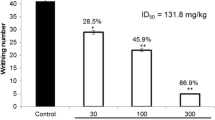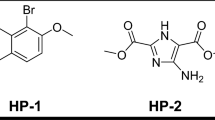Abstract
Two extacts ofCannabis sativa herb, one being cannabinoid-free (ethanol) and the other containing the cannabinoids (petroleum), were shown to inhibit PBQ-induced writhing in mouse when given orally and also to antagonize tetradecanoyl-phorbol acetate (TPA) -induced erythema of mouse skin when applied topically. With the exception of cannabinol (CBN) and δ1-tetrahydrocannabinol (δ1-THC), the cannabinoids and olivetol (their biosynthetic precursor) demonstrated activity in the PBQ test exhibiting their maximal effect at doses of about 100Μg/kg. δ1-THC only became maximally effective in doses of 10 mg/kg. This higher dose corresponded to that which induced catalepsy and is indicative of a central action. CBN demonstrated little activity and even at doses in excess of 10 mg/kg could only produce a 40% inhibition of PBQ-induced writhing. Cannabidiol (CBD) was the most effective of the cannabinoids at doses of 100Μg/kg. Doses of cannabinoids that were effective in the analgesic test orally were used topically to antagonize TPA-induced erythema of skin. The fact that δ1-THC and CBN were the least effective in this test suggests a structural relationship between analgesic activity and antiin-flammatory activity among the cannabinoids related to their peripheral actions and separate from the central effects of δ1-THC.
Similar content being viewed by others
References
Pars, H. G., R. J.Razdan, and J. F.Howes. 1977. Potential therapeutic agents derived from the cannabinoid nucleus.Adv. Drug Res. 11.
O. L. Davies, J. Raventos, andA. L. Walpole. 1946. A method for evaluation of analgesic activity using rats.Br. J. Pharmacol. 1:255–264.
Gill, E. W., W. D. M. Paton, andR. G. Pertwee. 1970. Preliminary experiments on the chemistry and pharmacology ofCannabis.Nature 228:134–136.
Dewey, W. L., L. S. Harris, andJ. S. Kennedy. 1972. Some pharmacological and toxico-logical effects of 1-trans-δ8-and 1-trans-δ9-THC in laboratory rodents.Arch. Int. Pharmacodyn. 196:133–145.
Chesher, G. B., C. J. Dahl, M. Everinoham, D. M. Jackson, H. Marchant-Williams, andG. A. Starmer. 1973. The effect of cannabinoids on intestinal mobility and their antinociceptive effect in mice.Br.J. Pharmacol. 49:588–594.
Buxbaum, D., E. Sanders-Bush, andD. H. Efron. 1969. Analgesic activity of tetrahydro-cannabinol in the rat and mouse.Fed. Proc. 28:735.
Sanders, J., D. M. Jackson, andG. A. Starmer. 1979. Interactions among the cannabinoids in the antagonism of abdominal constriction response in the mouse.Psychopharmacology 61:281–285.
White, H. L., andR. L. Tansik. 1980. Effects of δ9-THC and cannabidiol on phospholipase and other enzymes regulating aracidonate metabolism.Prostaglandins Med. 4:409–411.
Burstein, S., andS. A. Hunter. 1978. Prostaglandins andCannabis VI. Release of arachidonic acid from HeLa cells by δ1-THC and other cannabinoids.Biochem. Pharmacol. 27:1275–1280.
Burstein, S. andA. Raz. 1972. Inhibition of prostaglandin E2 biosynthesis by δ1-tetrahydro-cannabinol.Prostaglandins 2:369.
Burstein, S., E. Levine, andC. Varanelli. 1973. Prostaglandins andCannabis II. Inhibition of biosynthesis by the naturally occurring cannabinoids.Biochem. Pharmacol. 22:2905–2910.
Barrett, M. L., D. Gordon, andF. J. Evans. 1985. Isolation fromCannabis sativa L of cannflavin: A novel inhibitor of prostaglandin production.Biochem. Pharmacol. 34:2019–2024.
Evans, A. T., E. A. Formukong, andF. J. Evans. 1987. Activation of phospholipase A2 by cannabinoids. Lack of correlation with CNS effects.FEBS Lett. 211:119–122.
Evans, A. T., E. A. Formukong, F. J. Evans. 1987. Actions ofCannabis constitutents on enzymes of prostaglandin synthesis: Antiinfiammatory potential.Biochem. Pharmacol. 36:2035–2037.
Parkes, M. W., andJ. T. Pickens. 1965. Conditions influencing the inhibition of analgesic drugs of the response to intraperitoneal injections of phenylbenzoquine in mice.Br. J. Pharmacol. 25:81–87.
Siegmund, E. A., R. A. Cadmus, andG. Lu. 1957. A method for evaluating both nonnarcotic and narcotic analgesics.Proc. Soc. Exp. Biol. 95:729–731.
Hendershot, L. C., andJ. Forsaith. 1959. Antagonism of the frequency of phenylbenzoquinone induced writhing in the mouse by weak analgesics and nonanalgesics.J. Pharmacol. Exp. Ther. 125:237–240.
Kinghorn, A. D., andF. J. Evans. 1975. A biological screen of selected species of the genusEuphorbia for skin irritant effects.Planta Med. 28:325.
Williamson, E. M., andF. J. Evans. 1981. Inhibition of erythema induced by proinflammatory esters of 12-deoxyphorbol.Acta Pharmacol. Toxicol. 481:47–52.
Williamson, E. M., J. Westwick, V. V. Kakkar, andF. J. Evans. 1981. Studies on the mechanism of action of 12-DOPP, a potent platelet aggregating phorbol ester.Biochem. Pharmacol. 30:2691–2696.
Collier, H. O. J., L. C. Dineen, C. A. Johnson, andC. Schneider. 1968. Abdominal constriction response and its suppression by analgesic drugs in the mouse.Br. J. Pharmacol. Chemother. 32:295–310.
Marks, P., G. Furstenberger, andE. Kownatzki. 1981. Prostaglandin E-mediated mitogenic stimulation of mouse epidermis in vivo by divalent cation ionophore A23187 and by tumor promoter 12-O-tetradecanoyl phorbol-13-acetate.Cancer Res. 41:696–702.
Humes, J. L., S. Sadowski, M. Galavage, M. Goldenberg, E. Subers, R. J. Bonney, andF. A. Kuehl. 1982. Evidence for two sources of arachidonic acid for oxidative metabolism by mouse peritoneal macrophages.J. Biol. Chem. 257:1291–1594.
Edwards, M. C., andF. J. Evans. 1987. Activity correlations in the phorbol ester series.Bot. J. Linn. Soc. 94:231–246.
Calson, R. P., L. O'neill-David, J. Chary, andA. J. Lewis. 1985. Modulation of mouse ear edema by cyclooxygenase and lipoxygenase inhibitors and other pharmaoclogical agents.Agents Actions 17:197–204.
Formukong, E. A., A. T.Evans, F. J.Evans. 1987. Inhibition of the cataleptic effect of δ1-tetrahydrocannabinol by noncateleptic constituents ofCannabis sativa L.J. Pharm. Pharmacol. (in press).
Author information
Authors and Affiliations
Rights and permissions
About this article
Cite this article
Formukong, E.A., Evans, A.T. & Evans, F.J. Analgesic and antiinflammatory activity of constituents ofCannabis sativa L.. Inflammation 12, 361–371 (1988). https://doi.org/10.1007/BF00915771
Issue Date:
DOI: https://doi.org/10.1007/BF00915771




